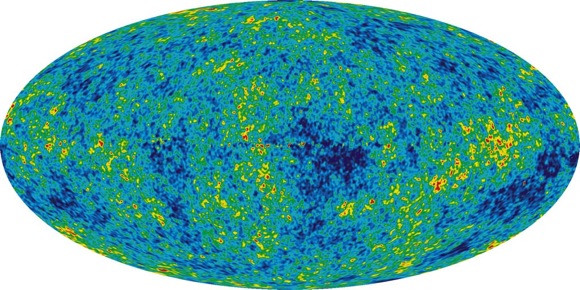We now know the Universe is around 13.7 billion years old. But just a few years ago, cosmologists had no idea, putting the range around 10-20 billion years old – some even thought it could be 100 billion years old. We can thank NASA’s Wilkinson Microwave Anisotropy Probe for giving us the concrete answer. And now, NASA released 5 years of data collection, telling astronomers more about the earliest moments in the Universe, the background sea of cosmic neutrinos and the end of the Dark Ages.
WMAP looks at the Universe with microwave eyes. It may sound like a strange wavelength to use when witnessing the highest energy event ever – the aftermath of the Big Bang. But there’s a trick, over the billions of years of time, the Universe has been expanding. Radiation has had its wavelengths stretched out across the billions of light-years of distance and expansion. The visible light after the Big Bang has become a diffuse glow of microwaves in all directions.
Astronomers use WMAP to study the subtle temperature variations in this microwave background radiation to understand what the Universe looked like at the very beginning.
This 5th anniversary release of data is the icing on the cake, with some significant new findings.
First up, WMAP found evidence for a background sea of cosmic neutrinos that permeate the background of the Universe. These almost weightless sub-atomic particles zip around at nearly the speed of light. In fact, there are millions passing through your body right now, blasted out from the Sun. They don’t interact with anything, so they don’t cause any harm. In fact, a neutrino could probably make it through several light years of solid lead without being stopped.
So, in addition to the solar neutrinos there seem to be a sea of background neutrinos, generated during the Universe’s early development.
The second big discovery is clear evidence that the first generation of stars took more than a half-billion years to create a cosmic fog.
“We now have evidence that the creation of this fog was a drawn-out process, starting when the universe was about 400 million years old and lasting for half a billion years,” said WMAP team member Joanna Dunkley of the University of Oxford in the U.K. and Princeton University in Princeton, N.J. “These measurements are currently possible only with WMAP.”
Finally, WMAP put in tight constraints on the concept of “inflation”. This was an incredible burst of growth in the first trillionth of a second of the Universe. This period of inflation left ripples in the fabric of space, detectable in the cosmic microwave background radiation.
All in all, it’s been a good 5 years for WMAP.
Original Source: NASA News Release


What are the estimated fight constraints of the inflation period?
x, y, z & time dimension
the edge is -infinity & +infinity
is it?
Inflation! How convenient to explain holes in the Big-Bang view! Tell me again — just what was the specific mechanism that created this period of “inflation” — in particular, how this happened. Stop telling me about this incredible “burst of growth” and try your theoretical physics on the HOW. Also, what stopped inflation; why didn’t it just keep on “inflating?”
In answer to “SayWhat”
Inflation was the original term used to describe the expansion of the universe, The term “Big Bang” is merely a nickname most people now use.
You also asked what stopped inflation. What makes you think it’s stopped?
This leads on to your next question,why didn’t it just keep on “inflating?”. Well, it DID keep on inflating and it continues today!.
Gee thanks. But I’m still looking for the mechanism/theory that created inflation. All I’ve heard is “a period when the normal laws of physics as we know them did not apply.” I’d hope to get a more creative answer from the tabloid readers — something exotic re dark matter, dark energy, extra dimensions rolled up so small we can’t detect them, lack of gravitons, et al. Looks like ‘ol Fraser has still got some work to do.
Can the author comment on the meaning of the differfent colors (red, yellow, blue, green, black) Does the CMB map indicate any blackholes in the universe or if the universe is even rotating?
In answer to “SayWhat” :
Ol’ Fraser got it covered, of course.
I’ve easily found not only one but four shows in “Astronomy Cast” that
could answer all your questions :
Inflation : http://www.universetoday.com/2007/10/15/podcast-inflation/
Questions on Inflation
: http://www.universetoday.com/2007/10/29/podcast-questions-on-inflation/
What is the Universe
Expanding Into? : http://www.universetoday.com/2007/03/20/podcast-what-is-the-universe-expanding-into/
The Big Bang and Cosmic
Microwave Background : http://www.universetoday.com/2006/10/10/podcast-the-big-bang-and-cosmic-microwave-background/
Astronomy cast is The Best Science Podcast of the Web : http://www.astronomycast.com/.
Ol’ Fraser is co-host in that.
Listen to the podcast and you will see by yourself.
Dr. Pamela Guay is such a good teacher that may be this time you will understand.
Enjoy !